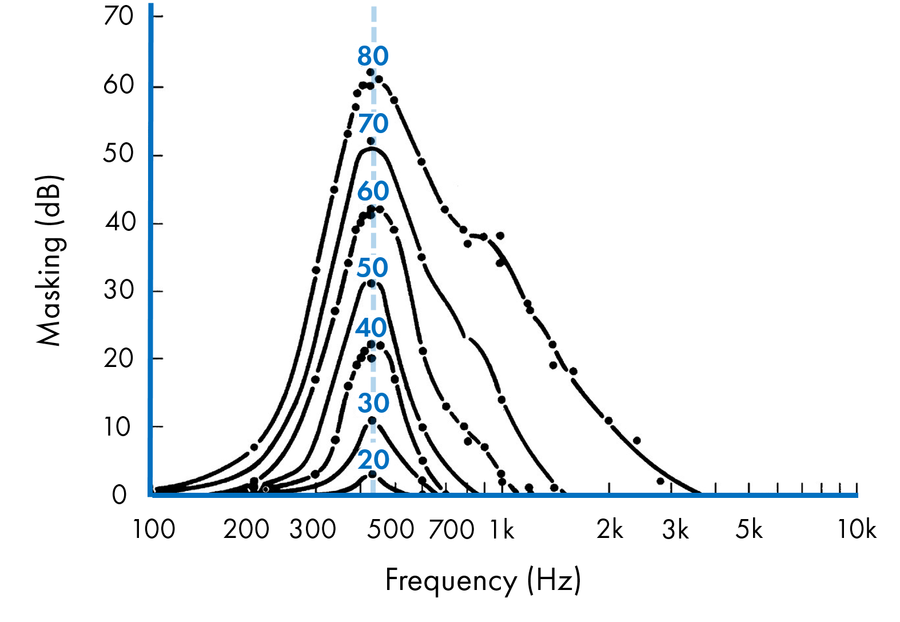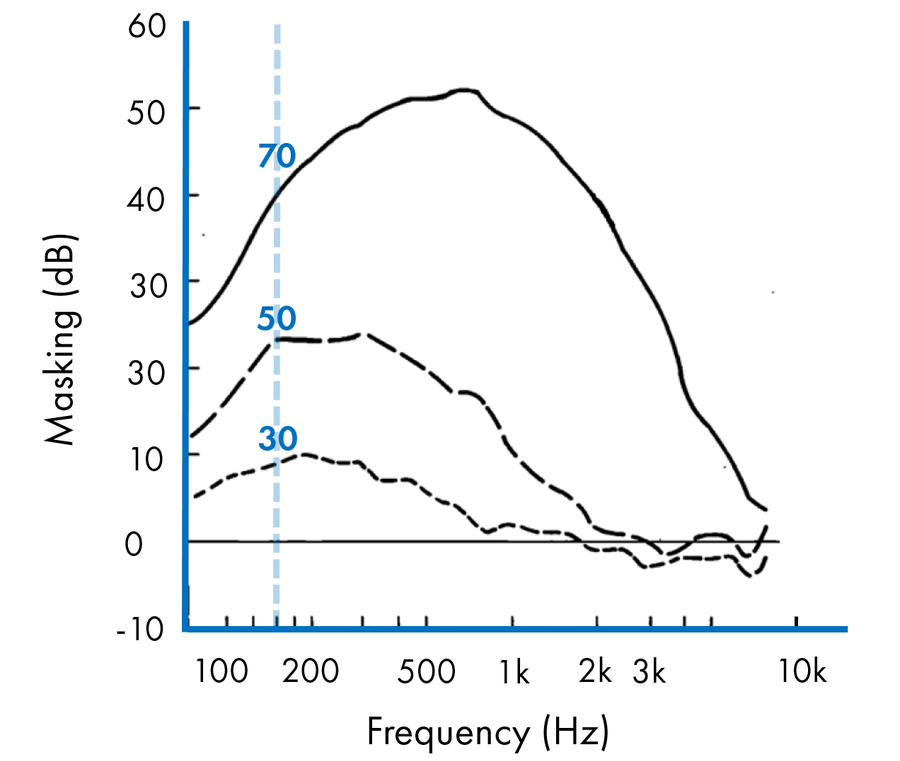What we hear is the complex combination of sound sources and their inherent audio characteristics interacting with the surrounding environment (in a room or outdoor), being decoded by our ears and brain. A number of loudspeakers and room-related topics have already been discussed in previous blogs (‘How to Best Setup Your Loudspeakers in Your Home Studio’, and ‘How to Correctly Place a Subwoofer in a Room’). This article will explore one specific aspect of human hearing and how it affects our perception of sound.
What is Auditory Masking?
Our ears work together with our brain to create the sounds we hear in our heads. If certain phenomena are directly related to our hearing devices (tympani, bones, cochlea, etc), separate aspects occur in our brain as it decodes the information received via the auditory nerves. One of them is called Auditory Masking, which is of particular interest as it can alter our perception of sound.
Auditory masking occurs when the perception of one sound is affected and compromised by the presence of another sound. Auditory masking in the frequency domain is known as simultaneous masking, frequency masking or spectral masking. Auditory masking in the time domain is called temporal or non-simultaneous masking. For this discussion, we will focus on simultaneous masking which occurs when a signal, the sound we want to hear, is compromised by a masking sound that is present at the same time.
Masked Threshold
Let’s move further and see what ‘masked threshold’ means. First, the unmasked threshold defines the quietest level of a signal we can perceive without a masking signal present. The masked threshold is the quietest level of the signal perceived when combined with a specific masking sound.
The amount of masking is the difference between these masked and unmasked thresholds. As an example, if the unmasked threshold is 20 dB and the masked threshold is 36 dB, the amount of masking would be 16 dB.
The basic auditory masking test involves unmasked thresholds measured on a subject. Then the masking noise is introduced at a fixed sound pressure level and the initial signal is presented at the same time. The level of the initial signal is varied until the new threshold is measured, defining this masked threshold.
Simultaneous Masking of Similar Frequencies
Simultaneous masking occurs when a sound is made inaudible by a noise, or masker, of the same duration as the original sound. How effective the masker is at raising the threshold of the original sound depends on the frequency of this sound and the frequency of the masker.
The greatest masking is when the masker and the sound are at the same frequency and this effect decreases as the sound frequency moves away from the masker frequency. This phenomenon is called ‘on-frequency masking’ and occurs because the masker and the original sound are within the same auditory filter, meaning that the listener cannot distinguish between them, as they are perceived as one signal.
Figure 1 below illustrates the phenomena of simultaneous masking using a masking tone centered at 410 Hz. You will notice that the masking patterns change depending on the masker intensity. At low levels, with masker sounds around 20 to 40 dB, the masking patterns are not affecting much our listening abilities. As the masker intensity increases (50 to 80 dB) the masking curves widen, especially for sounds at frequencies higher than the masker. This is called ‘upward-spread of masking’ and is why an interfering sound masks higher frequency signals much more than lower ones.

Masking at Lower Frequencies
Now, if we repeat the experiment using a 150 Hz masking tone, the result is wider upward-spread toward high frequencies. The auditory masking phenomena becomes stronger and extends further across the audio spectrum.

Altered Subjective Perception of Sound
Let’s explore now how auditory masking affects our perception of sound in the context of loudspeaker and subwoofer setups. From the examples and graphs above, we can anticipate that if reproduction levels are set too high in the low to low-mid frequencies, auditory masking will take place and mainly compromise our hearing abilities in the spectrum above the masking tones.
In any PA system, being in a room or outdoor, if a subwoofer is reproducing an excessive level of low frequencies, subjectively the low-mid spectrum will appear muddy, undefined, lacking in clarity and dynamic. The whole musical content over say, a low-mid octave, seems blurred and out-of-focus. Certain instruments’ level are seemingly too low, the audio mix is no longer balanced. Auditory masking will occur, irrespective of the design and quality of the loudspeaker or subwoofer. Your ear/brain loose some part of the information in the low-mid spectrum.
Similarly, the same phenomena can occur with a single loudspeaker if it is placed, for example, in a corner of a room, close to two solid hard walls, without any attenuation of its low frequencies. These room boundaries will change the acoustic radiation space for the loudspeaker and a bass boost of up to 12 dB will occur below 200 Hz in the loudspeaker’s response. That’s quite a bit of extra level, and this will induce compromised sound perception in the low-mid spectrum, again.
Minimizing Auditory Masking
There are multitude of scenarios where excessive bass levels are reproduced, leading to altered subjective perception of sound and musical content and now you may wonder: what could I do to avoid this? The answer is fairly simple.
Reducing excessive amount of low frequency level either in the mix or directly in the PA system may seem frustrating, at first, as bass levels are effectively no longer as prominent. However, the benefits in doing so are immediate on the sound definition and clarity you restore in the mid to low-mid spectrum. The aim is to find the right balance, as with everything.
Practically, how to reduce excessive bass levels? Adjusting the balance of the audio mix (from the main mixer output) is one possibility. If the content is pre-recorded and replayed, you will not be able to do this and you basically need to adjust your PA system. QSC K.2 Series™ loudspeakers and KS Series subwoofers all have on-board EQ, which allow you to easily setup a shelving-filter below 200 Hz, for example. These flexible and easy-to-use EQ can be setup and saved in the loudspeaker’s internal memory as user ‘Scene´, which can be recalled any time for your typical use cases.
Additionally, QSC TouchMix mixers provide all needed functionalities to adjust their main or Aux outputs precisely using typical EQ parameters.
Conclusion
When excessive low frequency content is reproduced via your PA system, the so-called auditory masking phenomena will occur, compromising your perception of sound. In order to retrieve definition, clarity and balance of the audio content, the reduction of some low frequency level is necessary. Doing so, all elements in the mix will be balanced again, recreating a proper three-dimensional sound stage. Remember that what we are listening to is the complex combination and interaction between the sound source, the environment we are in and the way our ears and brain decode sounds. It is useful, therefore, to understand the strengths and weaknesses of each element in the chain. Happy listening!
References
[1] Egan, J.P. and H.W. Hake, On the masking pattern of a simple auditory stimulus. The Journal of the Acoustical Society of America, 1950. 22(5): p. 622-630.
[2] Tobias, J.V., Low‐frequency masking patterns. The Journal of the Acoustical Society of America, 1977. 61(2): p. 571-575.
Christophe Anet
Latest posts by Christophe Anet (see all)
- History, Development and Applications of Column Loudspeakers - May 30, 2025
- Why is Dynamic Range so important? - May 30, 2023
- Differences between Flown and Floor-Mounted Subwoofer Deployments - May 2, 2023
